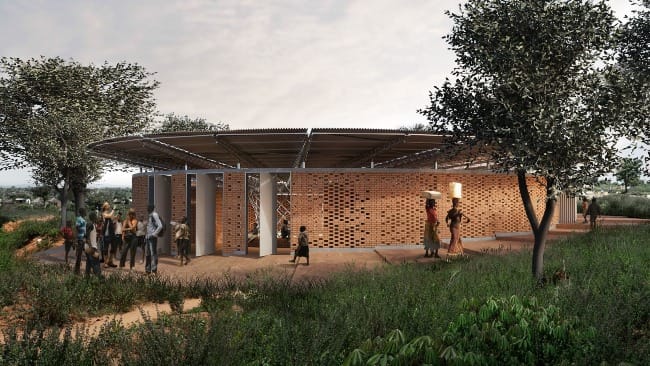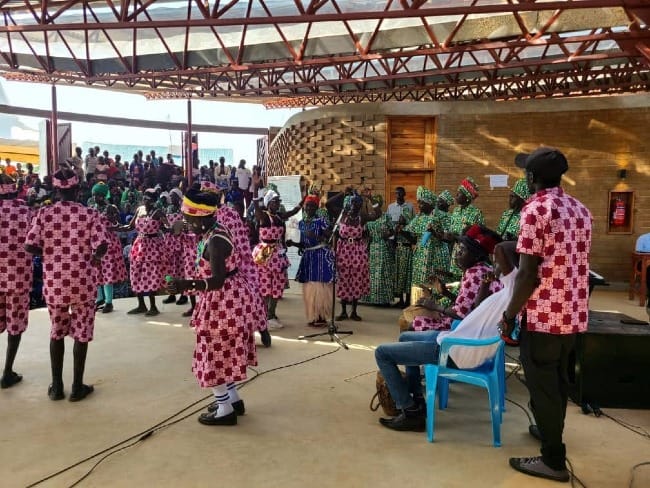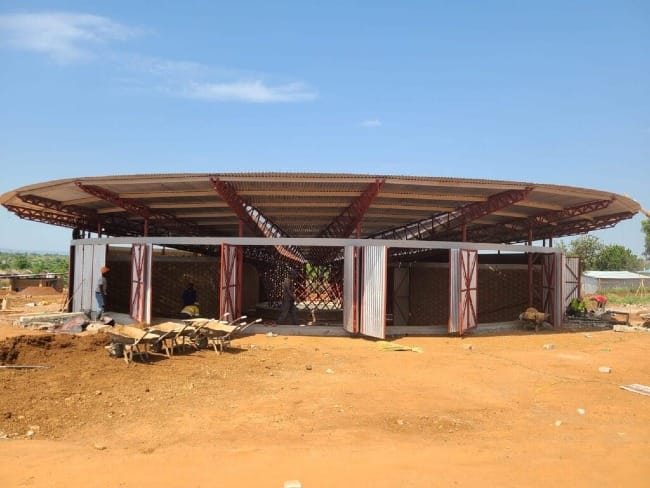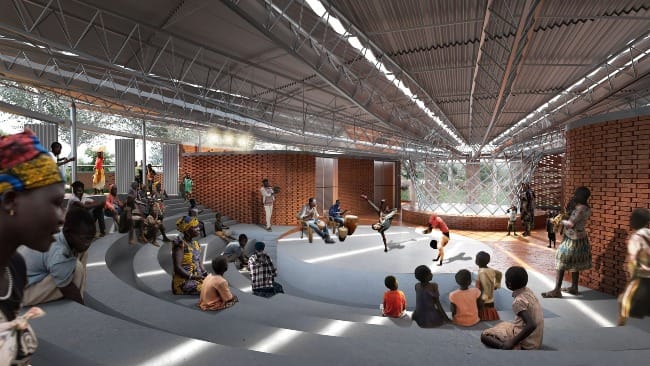In 2016, a huge, empty, arid patch of land near the northern Ugandan border with South Sudan was inundated with 270,000 refugees trying to escape the violence and horror happening in their homeland. The Bidi Bidi Refugee Settlement quickly sprang into being, becoming, at that time, the largest refugee settlement in the world.


Bidibidi Refugee Settlement
Uganda has some of the most welcoming refugee policies of any country in the world and has worked hard with other organizations to make places for the refugees that come there to settle rather than just camp.

In an atmosphere of trauma, need, and displacement, the recently inaugurated Bidi Bidi Music & Arts Centre—or “The Mushroom” as the locals call it—addresses needs of creative expression, collaboration, the remediation of boredom, and the building of community. These are needs usually overlooked in a refugee community, where the focus is on immediate practical needs such as food, shelter, and safety. But places like this can reconnect people with parts of their humanity that may seem to have displaced along with the physical displacement they have experienced.

The Seed of the Idea
The majority of the residents of Bidi Bidi are youth, often unemployed and suffering from boredom. During the inception of the project, residents were surveyed about what they most wanted to see in their community. The answer that came back was, “a place for dance, music and performance.” The young refugees told stories of aimlessness, including stories of friends who had committed suicide because there were no positive outlets available and no places to work through the trauma they had experienced.
"We want to change the narrative around refugees," said Nachson Mimran, CEO and co-founder of To.org, one of the organizing partners of the project. "Someone once told me that talent is equally distributed while opportunity is not, and that became really apparent when I first visited a settlement in Uganda...In one week we interacted with so much talent – athletic talent, visual artists, beat boxers, rappers – but there was no infrastructure to support them. That's why we launched this mission...Whу ѕhоuld mіllіоnѕ оf реорlе wоrldwіdе bе dеnіеd ассеѕѕ tо сrеаtіvе ѕрасеѕ ѕіmрlу bесаuѕе thеу hаvе bееn dіѕрlасеd duе tо соnflісt, сlіmаtе сhаngе оr fоr аnу оthеr rеаѕоn?"

The Building Plan
The Bidi Bidi Music & Arts Centre is a low, light-filled brick and steel amphitheater that provides classrooms, a recording studio, and spaces for music training. One side of the building has a series of doors that open, expanding into the outside space so that much larger numbers of people can be accommodated.
The lack of resources, combined with the desire and need for the building to be as sustainable as possible, led to many of the design decisions that were made. The use of wood was avoided because of the strain the large settlement was already putting on the trees in the area. As a result, a prefabricated steel roof, manufactured in the capital city, was used, and bricks for the walls were manufactured using local soil. Normally, bricks are fired using wood, but an alternative was found, compressing local soil and lime into the 50,000 bricks used for the walls, a process that uses the abundant local resources of soil and labor. By strategic interspersion of bricks and empty spaces, the brick walls became the sound diffusers and absorbers needed in a sound studio.
The goal was to make the building very low maintenance. This included eliminating the need for artificial light by creating openings in the brick walls and using light wells. The sunlight filtering through the bricks makes it possible for the building to function using only natural light.
The roof is designed to collect rainwater when it flows down the slope of the roof, into a funnel at the center, and then into a large tank where it is collected and stored. People in the community can then come and use it. Instead of using pumps to move water around, the system uses gravity. The hope is that this will reduce the current reliance on water being provided by humanitarian agencies and non-profits.
In addition to being an efficient building and a center for art and music, it also functions as a general gathering place for the refugees. It has a tree nursery and vegetable garden as well as the freshwater facilities—all important resources in a community where food and water shortages are increasing due to climate change.

The Community and Beyond
The project is a collaboration between several organization, one of which was founded by a man named Mawa Erezenio — a South Sudanese refugee who fled his country and now lives in Bidi Bidi. Tension between displaced members of different tribes was evident in the settlement, especially in its early years, according to Erezenio. But bringing residents together through the arts “can enable them to start thinking of the future (rather) than fighting among themselves,” he said. “We are bringing different tribes to perform together, and to exchange their cultural dances…We see it as a powerful tool for bringing peace and love among the community.” He believes his organization’s work has helped reduce the “individualism” he believes has been detrimental to the community.
Many see this project as a catalyst for more of its kind. With the climate crisis intensifying weather patterns, food shortages are expected to increase along with a growing number of refugees. Temporary camps are transitioning into permanent city-like settlements. Shifting the mindset around these places and people—both in welcoming and supporting them—involves remembering and supporting all aspects of them as people with experiences, gifts, and a variety of needs and interests.
Reflection Questions: Has art or music ever helped you navigate through a difficult time? Is there something you can learn from the welcome Uganda extends to refugees?
Feel free to leave a comment below or contact me directly at louise.conner@circlewood.online.
Louise
Want to learn more?
Find out more or support our parent organization by clicking below.